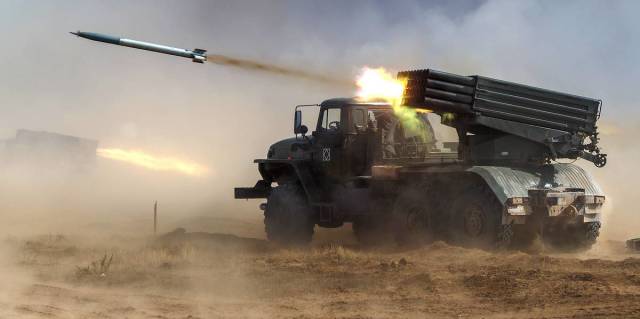November 22 marks the 105th anniversary of the birth of design engineer Vladimir Rogozhin, Hero of Socialist Labor. He was the author of 150 scientific and technical articles and 188 inventions, and led the development of world-famous Soviet jet systems
Rogozhin went from engineer to General Director of the company. He was one of the founders of a new direction in the production of ammunition for barrel artillery. As a leader, he provided the development of multiple launch rocket systems (MLRS) "Grad", "Grad-1", "prima", "Hurricane", "Smerch", "dam", "Rain", "Fire", "boa", and their introduction into mass production with the creation of highly mechanized and automated sections.
"He was a ' technologist from God'. In 1951, he received the Stalin prize for the development of sleeve steel technologies. In 1963, headed "fusion" (now called the scientific-production Association "ALLOY" to them. A. N. Ganicheva, included in the control loop NPK "tehmash" the technodynamics, part of state Corporation rostec - approx. TASS). Together with the General designer Alexander Nikitovich Ganichev, they turned out to be an excellent tandem. They created products that later became known all over the world, - Alexander Smirnov, General Director of the NGO "SPLAV", told TASS. - Rogozhin was at the origin of the creation of an entire industry for the production of multiple launch rocket systems (MLRS). Under his leadership, three new mechanical plants were built, five enterprises were modernized, including two mechanical Assembly plants. For this work, he was awarded the title Hero of Socialist Labor."
"We managed to invent plastic casings"
Rogozhin was born on November 22, 1915 in Tula in the family of an employee. In 1936, he graduated with honors from the Tula mechanical Institute and was sent to plant No. 187 "Novaya Tula" (now - Tula combine plant). When it became necessary to evacuate the plant during the great Patriotic war, he took an active part in dismantling the equipment of the press shop, sending it to the city of Novosibirsk and installing it in a new place. In the shortest possible time, production was launched, and thanks to the introduction of a reduced technological process, the number of produced cartridges increased dramatically without compromising on quality. For this, he was awarded the order of the red Star.
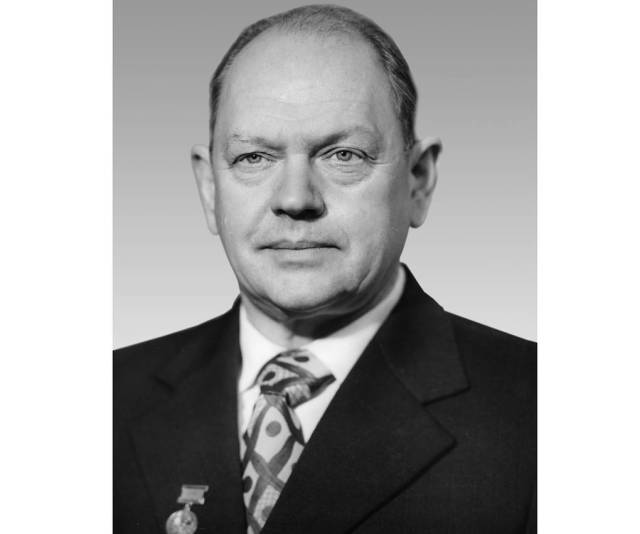
Vladimir Rogozhin
Image source: © Press service of the NGO "SPLAV" named after A. N. Ganichev
With great difficulty, in the middle of the war, he managed to return to Tula. At that time, there was an acute shortage of specialists in the East of the country, and they did not want to let him go. In 1943, Rogozhin continued to work at his factory and by the end of the war became the head of the shop. It was necessary to solve the problems of switching to the production of peaceful products.
Most fully, his talent as a design engineer, technologist and production organizer was revealed in 1946, when he moved to the research Institute No. 147 (now NPO SPLAV). The Institute provided the Soviet army with artillery casings using steel instead of the traditional expensive brass.
"We were set the task to improve the sleeve production and replace brass sleeves with steel ones. This complex of issues was solved by "ALLOY". We managed to invent not only steel, but plastic cartridges," Vladimir Rogozhin recalled about that time in an interview with a Tula newspaper in 1995.
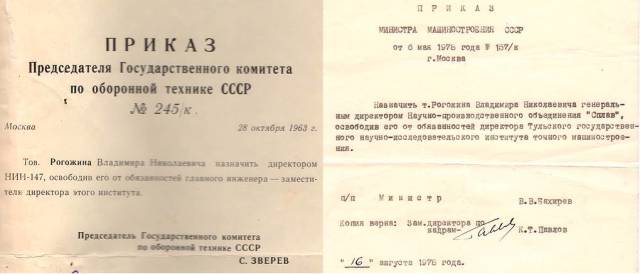
Orders on the appointment of Rogozhin as Director of research Institute-147 and Director of the NGO " Splav"
Image source: © Press service of the NGO "SPLAV" named after A. N. Ganichev
In 1951, for this work, a group of specialists, which included the head of the Bureau Rogozhin, was awarded the Stalin prize. Soon he was appointed chief technologist, in 1960-chief engineer. Three years later, Rogozhin already headed the Tula enterprise.
"I started out as a simple engineer, but I worked my way up to CEO without jumping a single step of the career ladder. Vladimir Nikolaevich aroused the respect of others not by flattering and fawning over his superiors, he was just a professional and decent person. At the time when Directors were removed for the slightest mistake, he managed to work as the head of the defense Institute for almost a quarter of a century, - his son Alexander Rogozhin recalled in an interview with the Tula Izvestia newspaper. - Among themselves, the designers of the "Alloy" called Rogozhin an intellectual. For broad views, code of honor, and love of the Motherland."
Time of "Grads" and " Tornadoes"
For 22 years, until his retirement in 1985, Rogozhin led the technological development of multiple launch rocket systems. The base for them was the Katyusha rocket artillery installation, known during the great Patriotic war. The power, range, and striking power of the new systems were nothing compared to the previous ones. For their development, a strong team of designers, technologists, metallurgists, chemists and other highly qualified specialists was created.
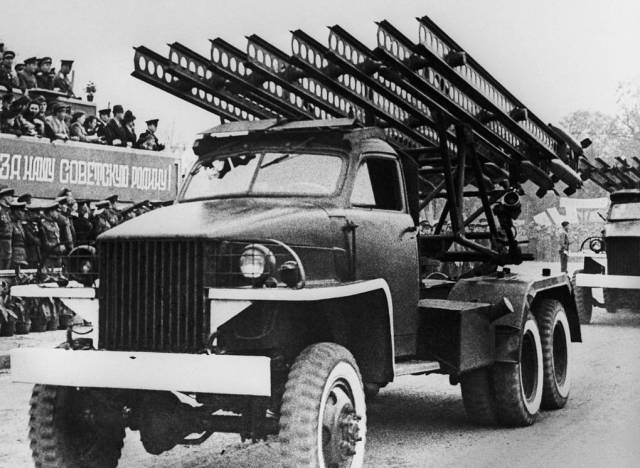
RZSO BM-13 "Katyusha", 1945
Image source: © TASS
"After the war, the question of further development of the enterprise became acute. Chief designer Alexander Ganichev managed to find a way out of the impasse. He offered to improve the multiple launch rocket systems, " Rogozhin recalled in an interview. - "Katyusha", which played a huge role in the war, in the post-war years remained, in fact, unattended. Everyone plunged into space problems. The designers of the "Alloy" managed to improve the jet systems, make them more powerful, mobile and long-range. Along the way, our engineers upgraded shells and vehicles. To a certain extent, this was a new word in the development of artillery."
"My father headed the Institute in 1964 - at a difficult time, when the production of Grad installations was just beginning. The place of production was determined by the Stamp plant. Prior to this, the company manufactured samovars, commercial equipment and casings. And now we had to create new production facilities! - told the son of a design engineer. - People who have never had anything to do with MLRS in their lives had to learn grad ammunition from scratch.
There was no production of this scale either before or after that time. According to Rogozhin's son, from 1965 until perestroika, Shtamp worked three shifts six days a week and two more shifts on Sundays.
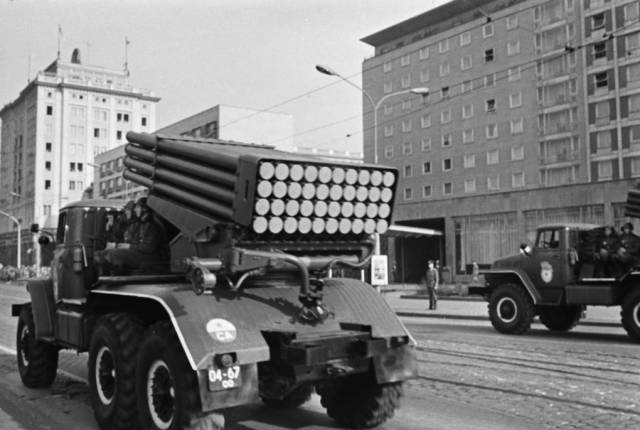
MLRS BM-21 "Grad" on cars on Ural-375D, 1970
Image source: © Nikolay Akimov/TASS
Alexander Rogozhin, son of Rogozhin
Rogozhin recalled that, as the General Director of the company, "experienced the attention of the authorities." "But the control was carried out exclusively correctly. First of all, contacts with foreign citizens were tracked. I was calm about it, because the state security officers were doing the right job-protecting the state interests, " he said. But there were also moments that could not be influenced, "because decisions were made at the highest level."
Vladimir Rogozhin, from an interview with the Tula newspaper
MLRS 9K51 "Grad" (122 mm caliber with a range of up to 20 km) - the most popular in the world. It was created in 1963 by a group of Russian developers under the leadership of chief designer Alexander Ganichev.
"Ganichev and Rogozhin-it was a great tandem of designer and technologist. That's why such excellent weapons systems were created. Why was Grad so popular all over the world? Rogozhin created the technology of unpopulated production, so they could make these orders in huge batches a year. It was cheap, and everyone bought it. Its unguided rockets were so technically accurate that they could hit a single point. Therefore, The grad's combat capabilities have expanded to a level that in those years could be considered fantastic, "Rudolf Kobylkin, a former chief technologist of the enterprise and now a veteran of the SPLAV NGO, told TASS.
It was the BM-21 Grad field rocket system that became the base for a number of other domestic systems for firing unguided 122 mm projectiles - "9K59 prima", "9K54 Grad-V", " Grad-VD", "light portable rocket system Grad-P", 22-barrel ship "A-215 Grad-M", "9K55 Grad-1", BM-21PD" dam " - and some foreign systems,including: RM-70, RM-70/85, RM-70/85M, Type 89 and Type 81. Also, the BM-21 itself has more than five variants of modifications.
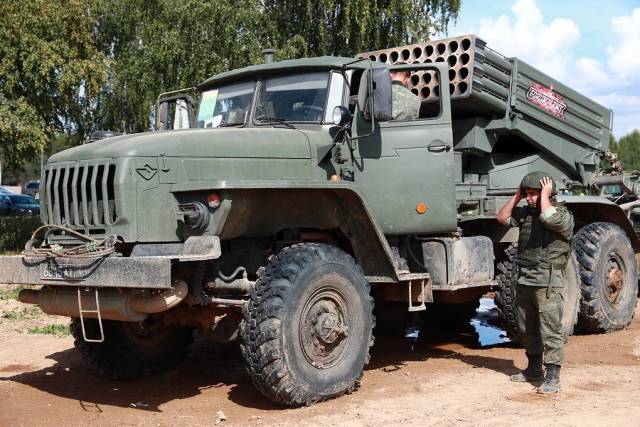
RZSO " Tornado-G"
Image source: © Sergey Fadeichev/TASS
Today, the Russian army is armed with the most modernized version of the "Grad" - 9K51M "Tornado-G". In comparison with the old model, it has a much longer range and maneuverability, but the main difference is in the modern navigation system. Using satellite navigation and computer calculation of ballistic indicators, the system can be aimed at targets automatically.
The "grad" was replaced in 1975 by the "Uragan" MLRS (projectile caliber-220 mm, firing range-35 km). The machine was made on the basis of ZIL-135LM and had 16 charges in one salvo. "Hurricane" was a baptism of fire in Afghanistan, more than once helped the Soviet, Russian army, as well as the allies. The last test for him was the mission to liberate Palmyra in Syria.
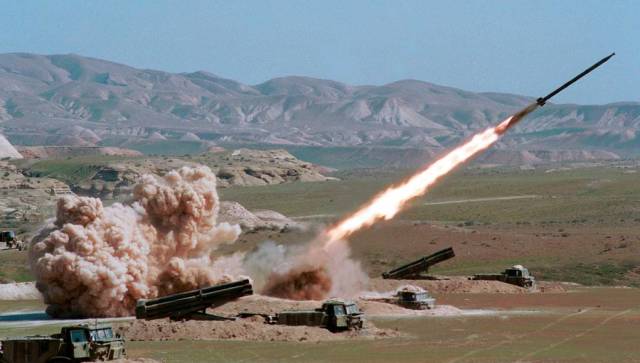
MLRS " Hurricane"
Image source: © Sergey Zhukov/TASS
In 1987, the first "Smerch" rolled off the Assembly line, which still consistently serves not only the Russian army, but also a number of other countries. It has the best characteristics among MLRS. The range of its shooting in various modifications is 70-90 km. The accuracy of the hit exceeds the accuracy of analogs by two to three times. Due to its effectiveness and range, Smerch is close to tactical missile systems, and is similar in accuracy to an artillery gun.
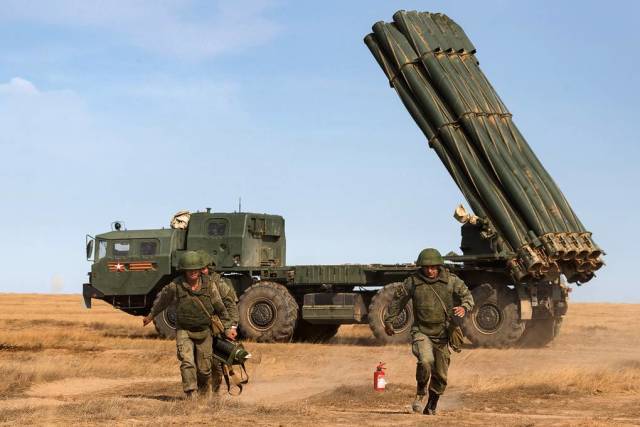
MLRS "Smerch"
Image source: © Vadim Savitsky / press service of the Russian defense Ministry/TASS
It is expected that by the end of 2027, the existing "Smerchi" and outdated "Uragan" systems will be completely replaced with large-caliber "Tornado-S" MLRS, which have improved characteristics and an expanded range of missiles. The Grads will also be replaced with the Tornado-G medium-caliber MLRS. The time of "Grads" and "Tornadoes" will go down in history.
"All my work is connected with the improvement of Russian artillery, strengthening the country's defense capability," Rogozhin said. - Of course, I Express great regret that our brainchild - "Grad", "Hurricane" - is actively used in regional conflicts. Multiple launch rocket systems should be a deterrent and used to destroy enemy personnel and equipment. But not against civilians and cities. This is a very powerful weapon. I was doing the right thing for everyone."
Roman Azanov
TASS thanks the press service of the NGO "SPLAV" for their help in preparing the material"
